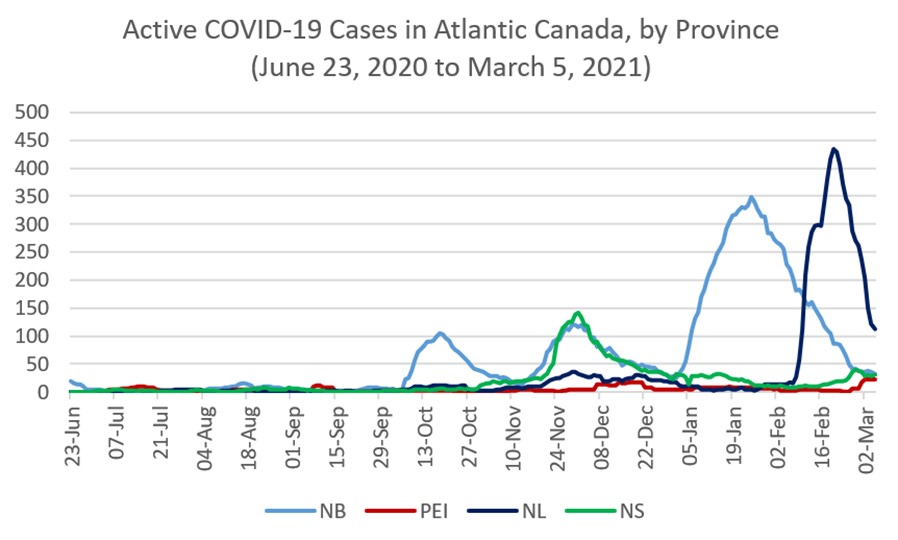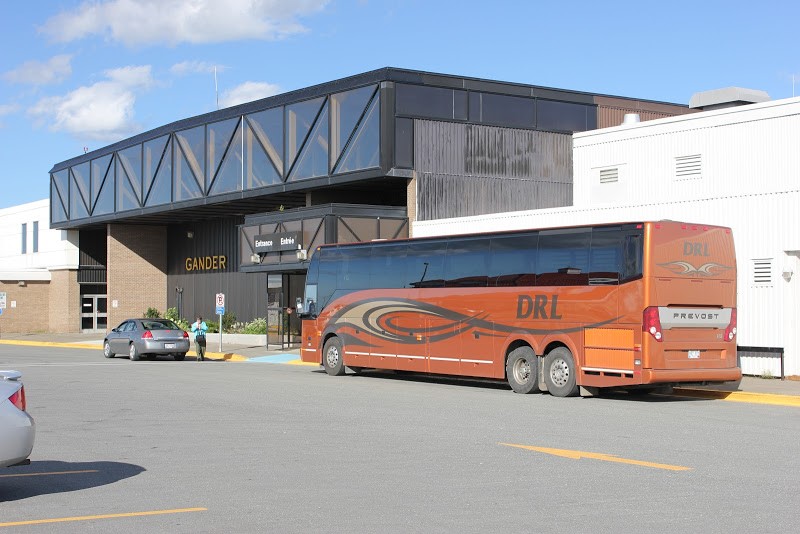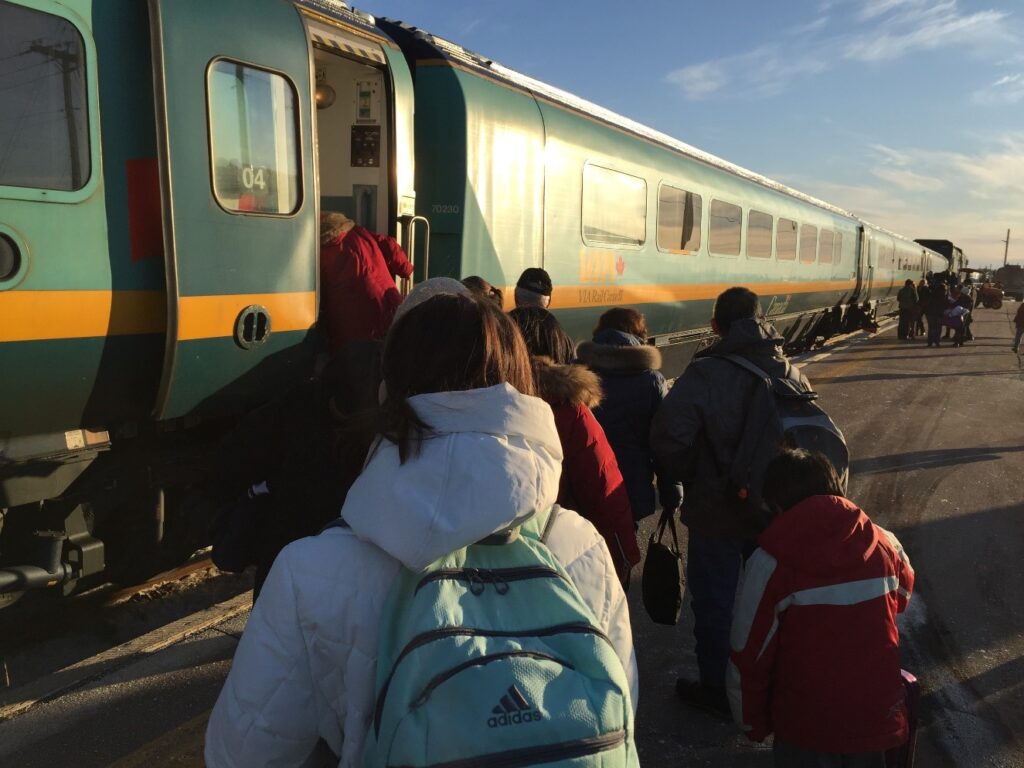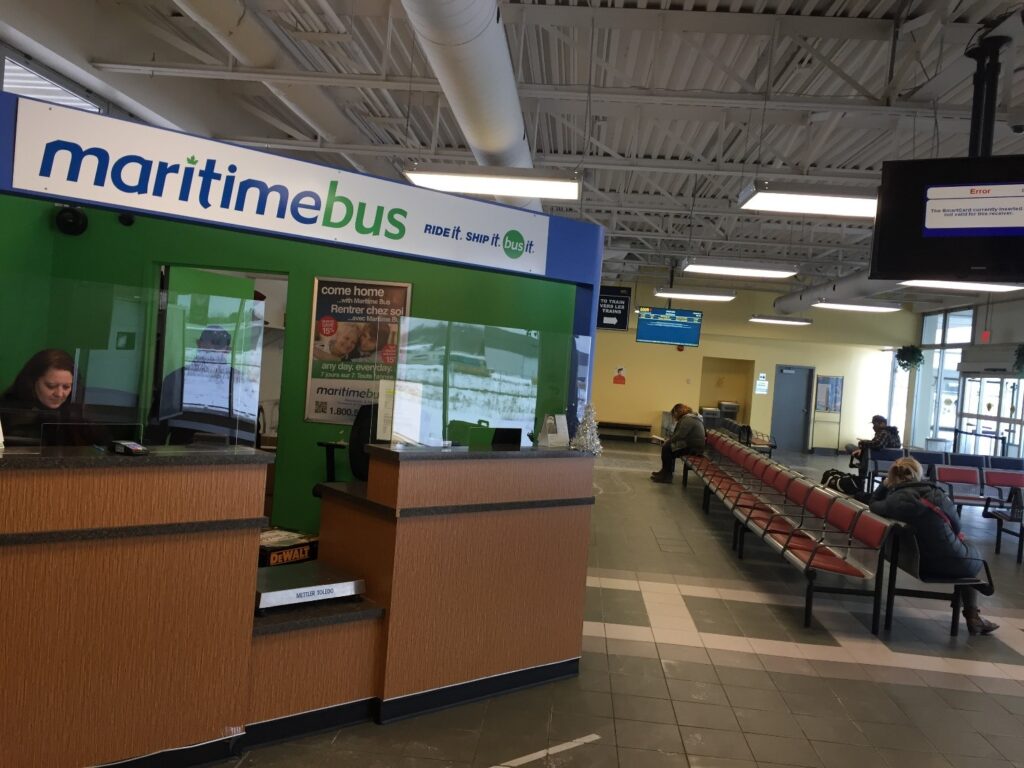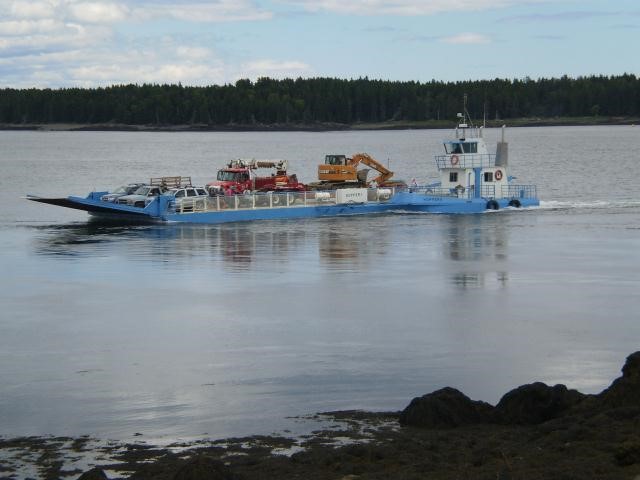Welcome to the April edition of Atlantic Transport News!
Here’s a look at what you’ll find in this edition:
- Marine Atlantic rate increase cancelled for 2021
- Atlantic Bubble may return this month
- Airline service shows signs of recovery
- Meanwhile, on the ground…
- Subsidy preserves Cape Breton railway for another year
- Transit union mounts advocacy effort
- Petitcodiac crossing closure brings transit opportunity
- Campobello ferry issue may be tested in court
- Refocusing our publication efforts
MARINE ATLANTIC RATE INCREASE CANCELLED FOR 2021
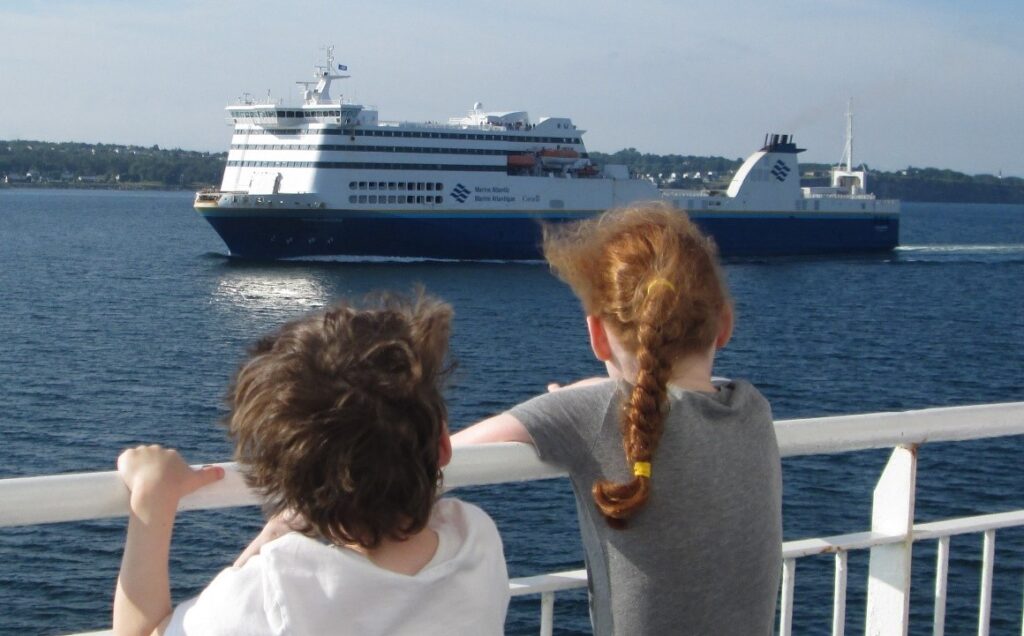
The campaign for lower rates on the Marine Atlantic ferry service linking the island of Newfoundland with the mainland has shown its first sign of success. Faced with pressure from various advocacy groups, Transport Canada appears to have backed down on its demands for 65% cost recovery – at least for 2021. After just five days under a new tariff that increased passenger fares on the seasonal Argentia ferry and freight transportation and handling charges on both its routes, the federal Crown corporation announced a price rollback to 2020 levels. Customers who had paid higher rates for completed or future travel are to receive refunds.
Transport Action Atlantic has been playing a leading role in advocating for lower ferry charges for several years, but the effort gained traction in recent weeks when Municipalities Newfoundland and Labrador formally joined the cause. The issue also found its way to the floor of the House of Commons. During question period on March 9, MP Jack Harris (NDP-St. John’s East) asked the Prime Minister to reverse the latest round of increases. Although Transport Minister Omar Alghabra gave only a non-committal response, the message appears to have gotten through to the province’s six Liberal MPs. They reportedly pursued the matter with the minister, leading to the rollback directive.
TAA views the concession as winning just one battle in what may yet be a long war. It doesn’t change the reality that ferry rates have outstripped the cost-of-living index by a factor of three to one over the past two decades, and are not consistent with the intent of the Terms of Union under which Newfoundland joined Confederation in 1949. Neither is there any indication that Ottawa is backing away from its cost recovery demands in the long term.
ATLANTIC BUBBLE MAY RETURN THIS MONTH

Travel among the four Atlantic provinces without need for a two-week self-isolation may soon be a reality once again. In March, the four premiers agreed in principle to a tentative reopening on Monday, April 19. The date, however, is subject to change should new pandemic concerns emerge.
As of April 1, the total known active caseload in the region stood at 182 – 141 of which were in New Brunswick, where a significant outbreak had occurred in the Edmundston area in the province’s northwest corner near the Quebec border. Provincial authorities reacted quickly, imposing renewed restrictions aimed at containing the cluster and flattening the curve. Similar measures had been very successful in knocking down an alarming outbreak that had surfaced during February in eastern Newfoundland – one that was all the more critical because most cases were of the more contagious B117 variant. But New Brunswick’s chief medical officer Dr. Jennifer Russell cautions that the April 19 date is by no means a sure thing. Public health authorities will be monitoring the situation closely to ensure that it’s safe to reduce travel restrictions.
As April arrived, Newfoundland and Labrador was reporting only four active cases, while Nova Scotia had 24 and PEI 13. Overall, the prevalence of COVID-19 on a per capita basis in Atlantic Canada is currently far lower than in other areas of Canada. The case count at the beginning of April was just 7.5 per 100,000 population, at a time when vaccine rollout was rapidly gaining momentum.

AIRLINE SERVICE SHOWS SIGNS OF RECOVERY
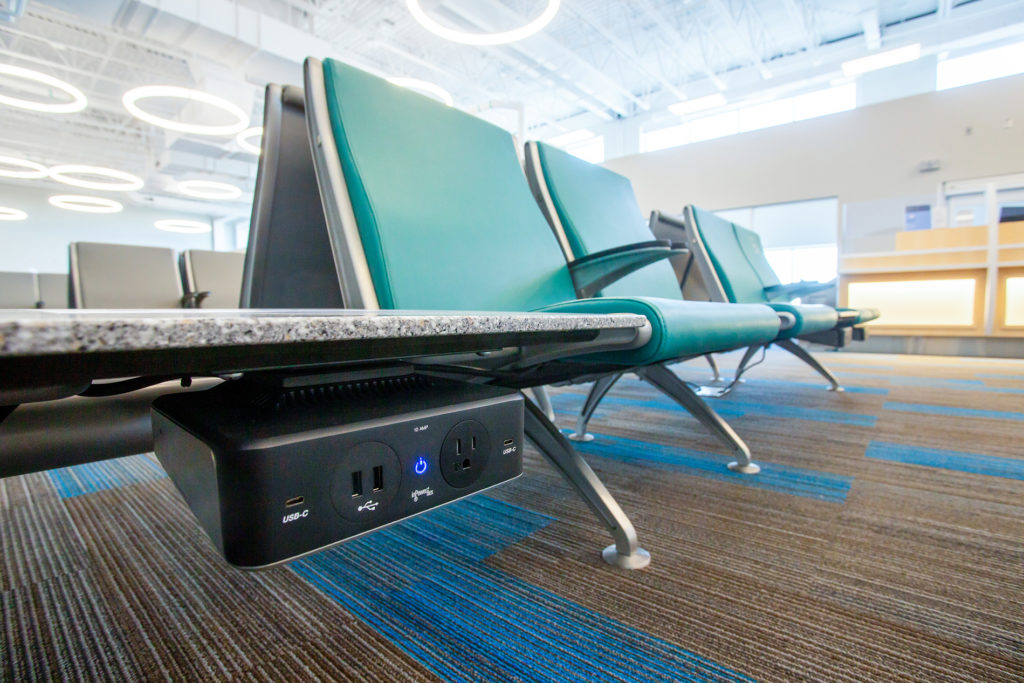
With the arrival of spring and the increasing availability of COVID-19 vaccines, Canada’s airlines are taking some cautious first steps toward restoration of regional services that were either greatly reduced or suspended entirely at the height of the pandemic. Not surprisingly, it won’t happen all at once, and ongoing travel restrictions between the Atlantic provinces and the rest of the country are expected to be a determining factor.
WestJet was first off the mark with an announcement on March 24 that services would be restored to Moncton, Charlottetown, Fredericton, and Sydney between June 24th and 30th. The suspended service between St. John’s and Halifax that had not been planned to resume until late June will instead return with six flights a week effective May 6. WestJet’s direct daily St. John’s-Toronto route will be back as of June 24. Seasonal services to Deer Lake and Gander will also be restored at the end of June.
“We committed to return to the communities we left, as a result of the pandemic, and we will be restoring flights to these regions in the coming months, of our own volition,” said airline CEO Ed Sims. “These communities have been a crucial factor in our success over our 25 years and it is critical for us to ensure they have access to affordable air service and domestic connectivity to drive their economic recovery.”
Meanwhile, Air Canada is preparing to resume some of its cancelled routes in the region as well. The acting CEO of Saint John airport, Greg Hierlihy, told CBC News they are gearing up for a restart of services to Toronto and Montreal in early June, but he acknowledged that it’s a bit of a moving target, one that is somewhat dependent on loosening restrictions on visitors to New Brunswick from other provinces to the west. He’s also optimistic about an eventual return of Porter Airlines, which has been in complete hibernation since March of 2020. Discounter Flair Airlines is planning to begin service from Saint John in June. Flair also has plans for four routes out of Halifax this summer.
PAL Airlines is anticipating stepping up its St. John’s-Deer Lake-Moncton frequency to three times weekly when the Atlantic Bubble reopens.
MEANWHILE, ON THE GROUND…
The trans-island DRL Coachlines service in Newfoundland resumed its daily operation between St. John’s and Port aux Basques on March 8, following a three-week total shutdown due to the sudden COVID-19 surge in the northeast Avalon, where a high proportion of its traffic originates. Maritime Bus is continuing to run just four days a week, but is anticipating a daily-except-Saturday operation once the Atlantic Bubble reopens.
It’s now been more than a year since VIA Rail abruptly ceased all service east of Quebec City. As of early April, reservations for both economy and sleeper space are still being accepted online for tri-weekly departures from May 16, but the likelihood of service resuming while travel restrictions remain in effect between Quebec and New Brunswick remains a big question mark.
SUBSIDY PRESERVES CAPE BRETON RAILWAY FOR ANOTHER YEAR

On March 25 the Nova Scotia government announced another year of provincial subsidy to the Genesee and Wyoming owned Cape Breton and Central Nova Scotia Railway (CBNS) to keep the railway across Cape Breton island in place, an extension of an ongoing agreement that has ensured that the railway will refrain from proceeding with formal abandonment of the line. If there is ever to be a hope of restoring this rail line to active use, keeping it in place remains a critical interim solution.
A rehabilitated rail connection is undoubtedly critical to any potential major port development in Sydney, but many advocates are now saying the case of restoring rail service doesn’t need to hinge entirely on that project moving ahead. Existing customers could return, and a restored rail line could serve to attract other new business to the region. Other options, like building a container transload facility in Sydney to allow Newfoundland-bound truck traffic to stay on rail instead of being transloaded to trucks at Moncton, could provide rail-supporting business while also taking a toll off highways, and helping to reduce the carbon emissions associated with transport that’s already taking place across the province. The Scotia Rail Development Society has been leading a push for funding from the Atlantic Canada Opportunities Agency to support exactly this kind of development.
Newly elected Cape Breton Regional Municipality Mayor Amanda McDougall has expressed support for the railway and its role in a greener transportation future for the region. In comments made to CBC News following the subsidy extension announcement, Mayor McDougall acknowledged that local businesses were making the case for the rail line regardless of whether the container terminal moving ahead, and spoke of the role a reinstated rail line could play in expanding the Cape Breton economy.
TRANSIT UNION MOUNTS ADVOCACY EFFORT

The Moncton local of the Amalgamated Transit Union is concerned that service reductions in municipal public transportation because of COVID-19 may result in what one spokesman refers to as a “death spiral” that presents an existential threat to transit. With municipal elections currently underway in New Brunswick, Sheldon Phaneuf says it’s an opportunity for candidates to declare where they stand, while recognizing that both the provincial and federal governments have a vital funding role to play.
Mr. Phaneuf, who drives for Codiac Transpo, has launched a media campaign and has prepared an opinion piece, which calls on governments to act before it’s too late.
“If service cuts weren`t enough,” he writes, “the death spiral phenomenon is being further accelerated by passenger capacity restrictions, imposed by provincial health authorities in response to regional COVID-19 outbreaks. These restrictions are necessary to safeguard the health of passengers and transit workers, but the impact on transit systems already crippled by service cuts is overwhelming.”
The full text of his commentary can be found on the TAA website:
PETITCODIAC CROSSING CLOSURE BRINGS TRANSIT OPPORTUNITY

It may be an opportunity to demonstrate the benefits of public transit to the 20,000 residents of Riverview NB. The bedroom community across the Petitcodiac River from Moncton will have to live within the constraints of a single span linking them to the city for the next six months. The final decommissioning of the controversial causeway that opened in 1968 began on April 5, and involves the removal of the tidal gate structure and diversion of the channel to its original route beneath a largely-completed new bridge. However, there is a lot of remaining work, including construction of the bridge approaches, which required complete closure of the causeway. This means effectively doubling of the traffic demand on the 15-year-old Gunningsville Bridge – well in excess of what it was designed to handle.
Until the new bridge opens at the causeway site in October, the Gunningsville span is anticipated to be carrying more than 50,000 vehicles each day. It’s a recipe for traffic congestion that has concerned municipal authorities on both sides of the river for several years. Among the planned mitigation measures is a transit option, but the big question is whether enough residents of the traditionally car-centric community will avail of it to make a difference.
Alex Grncarovski, operations manager for Codiac Transpo, says the plan calls for a frequent express bus linking a park-and-ride lot in central Riverview directly with downtown Moncton, where convenient connections can be made to numerous routes throughout the metropolitan area. A supervisor will be assigned to the parking lot at peak periods to help facilitate traffic flow. The direct bus will approach the bridge using a limited access route with no turns and just one traffic light, so delays are anticipated to be much less severe than those in the more heavily populated areas of the town.
While users will pay standard transit fares, they will be spared the expense of downtown parking, as the park-and-ride lot will be free of charge.
The commissioning of the new bridge this fall is expected to complete the restoration of the river to its natural state, and return the famous tidal bore to its former glory. The construction of the causeway a half-century ago resulted in unintended environmental consequences, including massive silting of the channel and a serious effect on fish habitat.
CAMPOBELLO FERRY ISSUE MAY BE TESTED IN COURT
Once again the seasonal ferry linking Campobello Island with the rest of New Brunswick via Deer Island has been extended – this time until the end of May. The most recent announcement from the provincial transportation department says the vessel will then be withdrawn for maintenance prior to starting its usual summer schedule. The provincial government evidently has no enthusiasm for maintaining this service on a year-round basis, making it clear that the extension is simply a response to the COVID-19 crisis, to allow island residents access without having to drive through the US.
The campaign for a permanent year-round link may yet find its way to the Supreme Court of Canada. The Campobello Island Year-Round Ferry Committee has begun preliminary discussions with local partners and regional law firms to pursue legal challenges, claiming that access to and from one’s own country without undue search and forfeiture are protected in the Canadian Charter of Rights and Freedoms.
In the late 20th Century, crossing the international bridge to Lubec Maine was quite a simple matter – but 9-11 changed all that. Subsequent tightened US border security, the requirement for passports, and annoyances such as the opening of Campobello-bound mail by US authorities have made life very difficult for islanders.
Campobello resident Ulysse Robichaud, a member of the ferry committee, told the Saint Croix Courier that they were encouraged by a virtual meeting with Premier Higgs last May, but the enthusiasm appears to have evaporated. Although both the PC MLA and the Conservative MP for the area are supportive of a year-round ferry to the rest of New Brunswick, there does not appear to be any momentum in either Fredericton or Ottawa.
Committee chair Justin Tinker says the Province of New Brunswick and the Government of Canada continue to ignore calls and e-mails from island leadership, who asking for nothing more than what has already been afforded to other remote locations: access to their own country.
REFOCUSING OUR PUBLICATION EFFORTS

Thank you for reading this, the sixth issue of our new monthly newsletter. Launched late last year, it’s an initiative designed to keep TAA members and other interested readers up to date with the latest transportation news from around our region. It also enables us to share Atlantic news more widely with interested people across the country, through a linkage with Transport Action Canada’s regular newsblast.
Over the past five years or so, we’ve made a special effort to add value to our printed twice-yearly Bulletin as an outlet for regional transportation news and opinion. While feedback has been generally positive, we’ve realized it’s an uphill, perhaps futile, struggle to make this publication a go-to source for breaking news. When a publication produced entirely by volunteers only appears twice a year, it’s a tall order to keep the content current and avoid the ever-present risk of being overtaken by events.
The latest Bulletin is behind schedule for a variety of reasons. It is at the printers as this is written, but members won’t receive their copies in the mail before mid-April. They’ll no doubt notice that some stories are already out of date. Hence the reason for a different approach. In November, we launched a monthly online newsletter, under the somewhat prosaic banner Atlantic Transport News. This collection of current transportation news from around the region seeks to fill a need that just isn’t possible with a biannual print publication. Our objective is to publish on (or shortly after) the first weekend of each month. Don’t hold us to that – this is, after all, a project of entirely volunteer effort! But all members and/or readers can help us with this, by contributing content, be it news tips, updates of happenings in your area, newsworthy photos, or complete short stories.
With this initiative comes a change in direction for the Bulletin. In the upcoming issue you’ll notice there’s less emphasis on news content, and more on in-depth features, analysis and opinion. In an era where the overwhelming majority of our membership and other followers enjoy access to the Internet, we think this approach makes sense, although we recognize that most members still appreciate receiving a hard copy in the mail twice a year – a tangible symbol of their membership they can hold in their hands and read at leisure.
Please, let us know what you think. You can reach us by e-mail at atlantic@transportaction.ca. Perhaps you might even have a suggestion for a more catchy name for this online publication, or some thoughts on how we can make the Bulletin a more appealing product and a more effective vehicle for promoting our agenda. But please don’t forget all this is an effort of volunteers – and we don’t have nearly enough of them. If you believe you have something to contribute, do not hesitate to step forward. TAA needs you!





